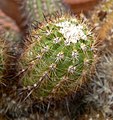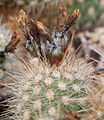| Mila caespitosa | |
|---|---|

| |
| Conservation status | |
 Vulnerable (IUCN 3.1) | |
| Scientific classification | |
| Kingdom: | Plantae |
| Clade: | Tracheophytes |
| Clade: | Angiosperms |
| Clade: | Eudicots |
| Order: | Caryophyllales |
| Family: | Cactaceae |
| Subfamily: | Cactoideae |
| Tribe: | Cereeae |
| Subtribe: | Trichocereinae |
| Genus: | Mila Britton & Rose |
| Species: | M. caespitosa |
| Binomial name | |
| Mila caespitosa Britton & Rose | |
| Subspecies | |
| Synonyms | |
|
Of the species:
Of M. caespitosa subsp. caespitosa:
Of M. caespitosa subsp. pugionifera:
| |
Mila caespitosa is a species of cacti (family Cactaceae) and the only species of the genus Mila. Its generic name is an anagram of Lima, Peru, the city near which the plant is found. The genus was first thought to comprise 13 species, until recent studies suggest they form one very variable species.
Description
The genus includes cacti that remain small, grow like a cereus, and sometimes sprout. The cacti with cylindrical, prostrate stems, about 30 cm long by 4 cm in diameter, they grow forming colonies. It has numerous low ribs covered with spines. The flowers are diurnal yellow. The fruits are small, globular, naked, green or reddish and juicy. The thorns are strong, stiff to soft and sometimes turn into hair bristles. The short-tubed flowers appear at the top, are funnel-shaped and usually yellow to whitish. The fruits are small, juicy and thornless berries.
Taxonomy
The first description of the genus Mila with the single species Mila caespitosa was published in 1922 by Nathaniel Lord Britton and Joseph Nelson Rose. The genus name is an anagram of Lima, the capital of Peru. The specific epithet caespitosa comes from Latin, means tufted and refers to the growth habit of the species.
The history of the genus is characterized by a large number of first descriptions of supposedly independent species. The reason for this lies in the great variability of the species. In Walther Haage's work, 11 species and several subspecies are listed. David Hunt has 4 species. In recent literature, the genus is considered monotypic with only one species, Mila caespitosa. This classification is supported by molecular biological studies.
Subspecies
As of October 2023, Plants of the World Online accepted two subspecies:
- Mila caespitosa subsp. caespitosa
- Mila caespitosa subsp. pugionifera (Rauh & Backeb.) D.R.Hunt
Distribution
The species ranges across the western Andes in Peru at an altitude of 1000 to 2500 m.
References
- "The IUCN Red List of Threatened Species". IUCN Red List of Threatened Species. 2011-05-07. Retrieved 2023-09-24.
- ^ "Mila caespitosa Britton & Rose". Plants of the World Online. Royal Botanic Gardens, Kew. Retrieved 2023-10-15.
- ^ "Mila Britton & Rose". Plants of the World Online. Royal Botanic Gardens, Kew. Retrieved 2023-10-15.
- "Mila caespitosa subsp. caespitosa". Plants of the World Online. Royal Botanic Gardens, Kew. Retrieved 2023-10-15.
- "Mila caespitosa subsp. pugionifera (Rauh & Backeb.) D.R.Hunt". Plants of the World Online. Royal Botanic Gardens, Kew. Retrieved 2023-10-15.
- Vandenbroeck, F. J. (1982). "Mila caespitosa (Br. et R.) [Desert cactus, ecology, taxonomy, Peru]". Succulenta. ISSN 0039-4467.
- Carnegie Institution of Washington Publication. Vol. III. Carnegie Institution of Washington. 1922. pp. 211–212.
- Anderson, Edward F.; Eggli, Urs (2005). Das grosse Kakteen-Lexikon (in German). Stuttgart (Hohenheim): Ulmer. pp. 434–435. ISBN 3-8001-4573-1.
- Britton, Nathaniel Lord; Eaton, Mary E.; Rose, J. N.; Wood, Helen Adelaide (1919). The Cactaceae : descriptions and illustrations of plants of the cactus family. Washington: Carnegie Institution of Washington. doi:10.5962/bhl.title.46288.
External links
- [REDACTED] Media related to Mila caespitosa at Wikimedia Commons
- [REDACTED] Data related to Mila caespitosa at Wikispecies



